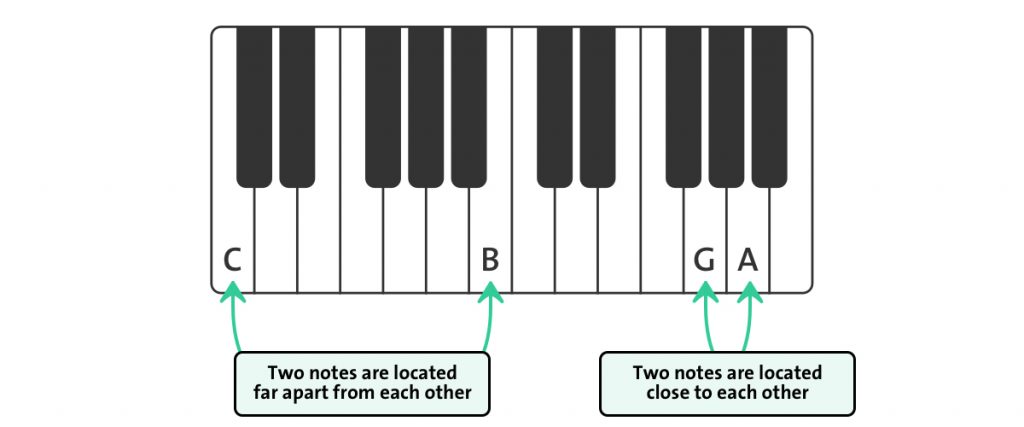You’ve probably heard that notes in melodies and chords can be located either far from each other or close. But how can we measure this distance between two notes? The answer is music intervals. Read on to find out how we can use them, what they are exactly and when we can use them?

What is a music interval?
Music intervals are used to measure the distances between two different pitches notated by notes in Western music theory. The unit of measurement for the distance between two notes is a whole tone and semitone.
What are the main music intervals?
There are 12 main intervals in the Western music theory:
- minor second (semitone)
- major second (whole tone)
- minor third (whole tone and semitone)
- major third (two whole tones)
- perfect fourth / fourth (two whole tones and one semitone)
- tritone (three whole tones)
- perfect fifth / fifth (three whole tones and one semitone)
- minor sixth (four whole tones)
- major sixth (four whole tones and one semitone)
- minor seventh (five whole tones)
- major seventh (five whole tones and one semitone)
- octave (six whole tones)

Play these intervals on your instrument and try to familiarize yourself with the sound. Being able to recognize intervals by ear is a great contribution to your musical skills. Read on to find out why.
Why do I need to know music intervals?
Music intervals are essential for developing your relative pitch, which is the ability to determine notes based on surrounding, reference notes. Your relative pitch comes in handy in the following two musical situations: recognizing chords or identifying melodies. Both cases will help you advance your music skills, like determining the key of a musical piece, tuning your instrument, improvising or singing.
Recognizing music intervals melodically
The first musical situation where you can put your relative pitch and knowledge of music intervals to work is when you want to play a melody by ear. In this case, we are identifying music intervals between notes that are played successively, in other words horizontally or melodically.
In general, if you are familiar with music intervals and how they sound, you can identify the notes of a melody by moving sequentially from the first known note to the other unknown notes that come next.
Let’s make it a bit more specific. Imagine that you are trying to recreate the melody shown in the picture below by ear. You know that it starts with an F note. In order to find the next note you have to listen carefully to determine the music interval between the unknown note and the F. With a well-trained relative pitch you will hear that this sounds like a major sixth — four whole tones and one semitone. Since the unknown note sounds higher, you’ll count four whole tones and one semitone up from the F note; and you’ll end up on the D note.

Recognizing music intervals harmonically
Another musical situation where your relative pitch and knowledge of music intervals will be of use is when you’re trying to recognize chords. Here we are recognizing a music interval between two notes that are played simultaneously, in other words vertically or harmonically.
If you have trained your ear to recognize music intervals in notes that are played simultaneously, you can recreate the composition chords by ear when only one note is known to you.
Let’s look at an example. Imagine hearing the chord shown in the picture below and knowing that the lowest note of the chord is a C. If you listen to the chord again, you try to pick up the music interval between the C note and the next note in the chord. To a trained ear that will sound like a perfect fifth — three whole tones and one semitone. Counting that distance from the C note, you’ll get the G note. If you repeat this process from the G note, you’ll also hear a minor sixth — four whole tones. Counting this distance from the G, you’ll get an Eb note.

Further to read:
Music interval Perfect fourth
Music interval Perfect fifth